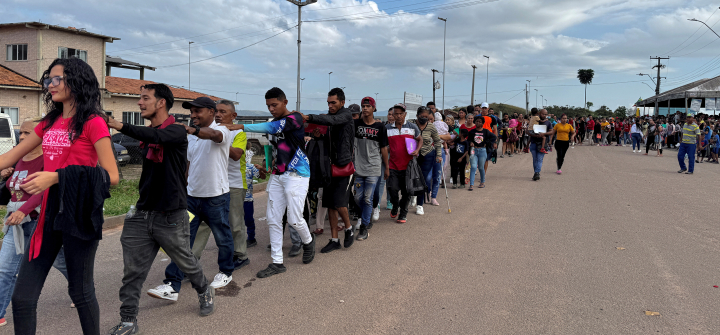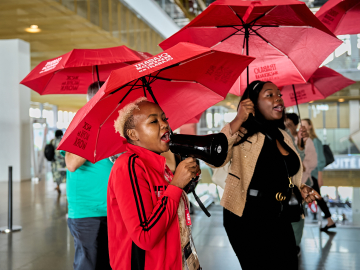Migration Response Done Right: Brazil’s Model for a World in Crisis
This is the first story in a 3-part series. See also Part II, From Displacement to Exploitation: Inside Brazil’s Human Trafficking Crisis, published on July 30, 2025, and Part III, The Women Protecting Migrants in Brazil’s North, published on August 1, 2025.
PACARAIMA, Brazil—Maria* steps out of a white truck on January 10 and walks toward a crowd of newly arrived Venezuelans. This common drop-off point in Brazil is less than 150 meters (500 feet) from the official border, which is marked by two towering flagpoles on one side of the road. Behind her, the vehicle makes a U-turn, fading out of view as it passes back to Venezuela. On either side of the border, a maze of trochas (informal footpaths) cuts into rolling hills that stretch to the horizon. This labyrinth of unofficial crossings became the primary route of migration when the border was closed during the pandemic.
Maria is one of the nearly 8 million Venezuelans who have fled their country’s economic and political collapse since 2015. More than 1.2 million have entered Brazil through Pacaraima since 2018, according to the International Organization for Migration (IOM). Of these, 680,000+ have chosen to reside in Brazil, home to the third-largest population of Venezuelan migrants, after Colombia and Peru. Following President Nicolás Maduro’s contested re-election in July 2024, hundreds continue to arrive daily.
Alone and far from home, Maria has already overcome immense challenges to reach this point—but more lie ahead. Women and girls like Maria face barriers to fundamental human rights, including access to food, housing, education, employment, and health care, according to a 2023 study involving 9,000+ migrants in Brazil, Ecuador, and Peru led by Susan Bartels, an international expert on global health and migration from Queen’s University in Canada. Participants in the study shared personal accounts of gender-based violence and human trafficking, events often precipitated by lacking necessities.
Bartels says the study had an unexpected result: Migrants in Brazil rated their experiences as positive significantly more than those in Ecuador and Peru. The difference, she says, is the work of Operação Acolhida (Operation Welcome).
Highway 174 is the only road connecting Venezuela to northern Brazil, a busy entry point for arriving Venezuelan migrants. Image: Julianna Deutscher
Innovative Crisis Response
The Brazilian government launched Operação Acolhida in 2018, as a unique collaboration with UN agencies and NGOs. The partnership blends military logistical support with respect for humanitarian autonomy, a rare balance in crisis response.
On a typical day in Pacaraima, UN staff and the Brazilian military organize the arriving crowds into lines as excited chatter fills the air. When a staff member tells a group of migrants to proceed into the reception center, they erupt into cheers, jumping and raising their hands.
At that moment, their new life begins.
Maria’s arrival falls on a particularly momentous day: January 10—Maduro’s inauguration. Many Operação Acolhida staff are Venezuelans themselves, and the inauguration is a reminder of Maduro’s unrelenting grip on their home.
“Bom dia,” Maria nervously says in Portuguese to a UN worker wearing an iconic blue vest. Gabriela*, a Venezuelan who has been working for the IOM since 2019, responds in Spanish, and Maria’s face lights up.
Inside the reception center, migrants proceed through a streamlined process that connects them to essential services, free of charge. They apply for asylum or permanent residency, receive information on applying for universal health care, and pass through a vaccination clinic. Children run around the center’s playground, watched by UNICEF staff trained to offer psychological first aid. UNICEF has reported a rise in unaccompanied children crossing into Brazil since 2023. Their teams work closely with these children to screen for commons signs of human trafficking, such as young girls travelling with an “uncle” or children who have been working instead of going to school.
While the reception center alone surpasses many global migration responses, the real innovation lies deeper: its relocation (or “interiorization”) strategy. UN teams work alongside police and other agencies to reunite migrants with family or friends across Brazil, providing paid transportation. Employment services connect migrants to companies vetted for fair labor practices and again offer relocation support. Since 2018, over 150,000 have been voluntarily relocated to reunite with families or seek employment opportunities across 1,000+ municipalities.
“These programs do not exist in Colombia, Ecuador, or Peru,” says Victor Hugo Ruiz Hernandez, state delegate for the national migration conference, noting the interiorization strategy is essential to Operação Acolhida’s success. He cites Bartels’ finding that the programs help target risk factors that lead to human trafficking. Ruiz Hernandez emphasizes that providing shelter, food, employment, and paid transportation reduces vulnerabilities and eliminates the need to trade sex for survival. IOM teams offer education sessions on human rights, human trafficking, and navigating services. UN protection staff have identified potential cases of labor trafficking by calling employers or looking up jobs mentioned by arriving migrants to identify potential scams.
Free transport offers protection to caminantes (migrants traveling on foot). Ruiz Hernandez noted cases of vehicles striking pedestrians, kidnappings, and women being assaulted or forced into sexual exploitation.
Bienvenido a Brasil, Welcome to Brazil, reads the Spanish sign welcoming arriving Venezuelans to Operação Acolhida in Pacaraima. Image: Julianna Deutscher
Living While Waiting
While awaiting relocation, migrants can live in abrigos (large, fenced settlement compounds) provided by Operação Acolhida. Documentation, reunification, and employment support can take weeks to months. While they wait, some choose to move further into Brazil, to additional centers for Operação Acolhida in Boa Vista or Manaus.
Inside one of the five abrigos in Boa Vista, children chase one another between the rows of beige, prefabricated housing units, while dogs bark, and motos (motorbikes) echo in the distance. The soft creak of a hammock can be heard as a mother gently rocks her baby. The scent of campfire smoke drifts through the air from a communal cooking space where Indigenous families have gathered to share meals and tell stories in their mother tongue. The traditional practices are honored here in one of two abrigos open to all Indigenous migrants and designed with input from leaders of the two predominant communities, the Warao and Eñepá. Housing more than 1,500 people, this is the largest Indigenous migrant shelter in Latin America.
In a neighbouring abrigo, children play futebol (soccer), unphased by the scorching heat and humidity. A soldier proudly points to newly paved paths, designed to improve wheelchair access. LGBTQ+ individuals have access to gender-neutral bathrooms. Innovations like these, which aren’t offered in neighbouring countries, contribute to the positive experiences shared in Bartels’ 2023 study.
Migration is not always a one-way journey. Luisa* arrived during the pandemic when the border was closed. “I paid someone to help me get across. It was a tense and fearful moment because people were being caught and sent back,” she says. Two years later she returned to Venezuela to find her children. “I was determined to reunite with them.” She found them and brought them back to Pacaraima.
Luisa has also become the leader of one of the informal settlements, a community of Venezuelans who have chosen to live outside the abrigos. “People are asking for support and help with food, nutrition, and medicine for children,” she says, adding that she works with UN teams and NGOs to meet the people’s needs. Today, for example, an event is being held to assist families with school registration.
A Funding Crisis
The funding cuts to USAID and UN programs in early 2025 by the U.S. administration came at a most inopportune time. UNHCR, the UN Refugee Agency, reports that more people are currently forcibly displaced than at any point in recorded history. An employee of Caritas, one of the key international organizations in Operação Acolhida, says that even before the USAID cuts at the end of January, organizations had been leaving Brazil to respond to other global crises. “Right now, we have significantly fewer resources,” the Caritas worker said in early January.
Caritas provided an average of 1,800 meals daily to Venezuelan migrants and other local families in need until February 2025 when U.S. funding was suspended. The program partially resumed in May with funding from Catholic Relief Services, the Church of Jesus Christ of Latter-day Saints, and international donors. It is, however, only functioning at half its prior capacity. But they were able to restart their water, sanitation, and hygiene program in early July.
Other organizations, however, have yet to find alternative funding. The Inter-Agency Coordination Platform for Refugees and Migrants from Venezuela (R4V), which includes 200 organizations, reported $113 million would be needed for the refugee and migrant response in Brazil this year. But only 10% has been funded, as of July 17. More than $51 million is needed for the response in Roraima, the heart of Operação Acolhida, alone.
IOM has anticipated a 30% reduction in donor funding this year. Now, just weeks after celebrating the milestone of connecting 150,000 Venezuelan migrants to family and jobs since 2018, an IOM official says their activities in Brazil’s north will be gradually reduced starting next month. R4V reports IOM has received only 13.5% of the $38.4 million needed this year for IOM programs in food security, health, shelter, and other services in Brazil. Other UN agencies are in a similar crisis, with UNHCR at 15% and UNICEF at just over 2% of their estimated funding needs for refugee and migrant response in Brazil.
A Global Model
The global community must build bridges, not walls, says Selma Campos, a Venezuelan living in Pacaraima and president of a migrant rights organization. Migrants are not obstacles but drivers of progress, she says, adding that migrant contributions have helped stabilize the GDP in Brazil’s north. “Young people come here to pursue their dreams in Brazil, and they are determined to give their best,” she says.
Operação Acolhida is unique in Latin America—and the world—for its coordinated, government-led response to migration, says Bartels. "By providing structured relocation, documentation, and access to health services, it plays a critical role in improving health outcomes and reducing risks, particularly for women and children,” she says.
“Operação Acolhida serves as a global example of how to welcome and assist migrants and refugees by meeting their essential needs,” adds Ruiz Hernandez.
As Maria steps toward the crowd of Venezuelans that January 10 morning, Gabriela, the IOM worker, offers an encouraging smile—one last gesture of welcome to Maria’s new life.
“In Pacaraima, above all,” Gabriela says, “it’s a complete synergy of workers from around the world coming together towards the same goal: helping migrants.”
*Maria, Gabriela, and Luisa’s names were changed to protect their privacy.
Julianna Deutscher, MD, MPH, is an emergency physician in Canada. In addition to her clinical work, she contributes to global health projects focusing on medical education, trauma program implementation, migrant and refugee health, and human trafficking prevention. Deutscher reported this article as a Johns Hopkins-Pulitzer Global Health Reporting fellow.
Join the 50,000+ subscribers in 170+ countries who rely on Global Health NOW summaries and exclusive articles for the latest public health news. Sign up for our free weekday newsletter, and please share the link with friends and colleagues.
Venezuelan refugees walk after crossing the border between Venezuela and Brazil in the city of Pacaraima, Roraima State, Brazil, on September 13, 2024. Alan Chaves/AFP via Getty Images





